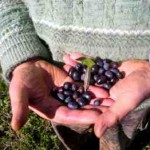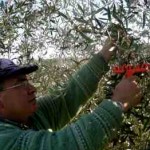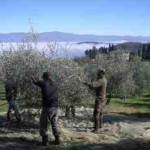
The olive harvest at Villa Campestri Olive Oil Resort in Tuscany
The olive harvest in Tuscany begins in late October and early November, just when the olives have reached their perfect stage of ripeness—actually a little under-ripe as they turn from green to black. It’s called invaiatura in Italian, veraisonin English.
At Villa Campestri, we harvest all our olives by hand. It takes longer than using machines but we’re convinced from years of experience that it’s less stressful for the trees and, equally important, there’s less risk of damage to the olives. Meaning, of course, a higher quality of extra-virgin oil.
For harvesting, we use a comb, a plastic instrument that looks much like a giant hair comb. It slides along the branches and pulls the olives off without damaging the leaves or the tree. The olives drop gently to a net spread beneath the tree and when the net is full, the olives are brought immediately to the mill or frantoio right here on the estate.
Like all conscientious growers, we press our olives within 24 hours (and often much less) of harvest. That’s the only way to get an oil that tastes and smells of the full, fresh, complex fragrance of the olives themselves.
The olive harvest lasts about a month. We have to finish before the arrival of cold weather at the end of November; otherwise, there is a risk of damage to the olives.
To see a video of the olive harvest at Villa Campestri Olive Oil Resort, click on our, click on our channel youtube.
Quick Booking snippet
Tuscany, an Italian region renowned for its cultural and historical wealth, is home to numerous UNESCO World Heritage Sites. These sites represent not just the architectural and artistic beauty of the region but also its significant historical heritage.
Italian cuisine, celebrated globally, is a mosaic of flavors and traditions. From the rolling hills of Tuscany to the bustling streets of Naples, each region contributes its unique essence to what we recognize as Italian cuisine. This culinary journey explores how history, culture, and regional diversity have shaped the renowned gastronomy of Italy.
Tuscany is world-renowned for its rich winemaking tradition, a heritage rooted in centuries of history and culture. In this detailed guide, which is like a true oenological journey, we will discover not only the fine wines of the region but also the traditions and landscapes that make Tuscany an unmissable destination for wine lovers.
In the heart of Italy, Tuscany stands out as one of the most emblematic regions for wine production. Famous for its landscape of gentle hills, cypress trees, and picturesque villages, this region is also a paradise for wine lovers. Tuscan vineyards, nourished by fertile soil and an ideal climate, produce wines that are appreciated worldwide […]
For those looking for a firsthand experience, the Agricultural Tourism Company Badia di Susinana offers horseback rides and trekking and riding courses with a guide, in addition to hospitality for horses and riders, located in Palazzuolo sul Senio. Alternatively, the Farm I Cavalli del Vento allows crossing beech forests and vast chestnut groves, with rides […]
Sport fishing in Tuscany offers a wide range of opportunities due to the abundance of inland and coastal waters in the region. Specifically, the province of Pistoia, with Lake Nievole in Serravalle Pistoiese, is renowned for trout fishing and other fish such as carp, grass carp, tench, and sturgeon, with a catch and release rule. […]
In Val di Chiana, to savor an authentic Chianina steak, there are several renowned restaurant options: 1. Ristorante Casa Cecco: Offers the chance to taste a Chianina steak in a farmhouse dating back to 1600. 2. Agriturismo di Trequanda: Here, Chianina meat, raised in local pastures and processed by the company’s trusted butcher shop, becomes […]
The Italian Quattrocento was a period of extraordinary artistic effervescence that produced numerous world-renowned artists. Among them, some of the most influential were: 1. Andrea Mantegna (1431–1506): A painter and engraver from Padua, famous for his frescoes in the Camera degli Sposi in Mantua.



